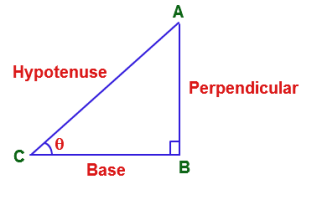You are using an out of date browser. It may not display this or other websites correctly.
You should upgrade or use an alternative browser.
You should upgrade or use an alternative browser.
projection of a perpendicular
- Thread starter jjoyjoy
- Start date
Please show us what you have tried and exactly where you are stuck.in a right-angled triangle, does the projection of the perpendicular on the base equal a)the base itself, b)zero, or c)perpendicular.?
Please follow the rules of posting in this forum, as enunciated at:
Please share your work/thoughts about this problem
Dr.Peterson
Elite Member
- Joined
- Nov 12, 2017
- Messages
- 16,093
Please show us the exact problem, including any picture that was either provided or made by you.in a right-angled triangle, does the projection of the perpendicular on the base equal a)the base itself, b)zero, or c)perpendicular.?
In particular, what does "the perpendicular" mean here, and what kind of "projection" is it asking about? Anything you can say about your knowledge of the concepts in the problem will help us understand both the problem, and how to help you.
If it has the meaning I think it does, the answer is almost obvious.
hi there! I apologize for not giving more details; this came as a multiple-choice question in our exam paper. I had to write the question from memory. No image was provided to us nor any blank space for any particular calculations. Not to mention, this is the first time I have come across a question like this so I have no clue as to what the answer might be.
Dr.Peterson
Elite Member
- Joined
- Nov 12, 2017
- Messages
- 16,093
I would suppose that "perpendicular" in the context of a right triangle means the side perpendicular to the side being use as the base; and "projection" means the orthogonal (right-angle) projection of that side onto the base. Imagine the shadow when the sun is directly overhead. How long would the shadow be?hi there! I apologize for not giving more details; this came as a multiple-choice question in our exam paper. I had to write the question from memory. No image was provided to us nor any blank space for any particular calculations. Not to mention, this is the first time I have come across a question like this so I have no clue as to what the answer might be.
But it's also likely that some part of the problem as you reconstructed it is wrong, as "perpendicular" makes no sense (unless it means the perpendicular side itself).
It would be helpful if you answered my specific questions, telling us what the two words mean in your class; words have different meanings both in different cultures, and in different fields of math. Are you learning about vectors, or about some other part of math in which the concept of projection is used?
Dr.Peterson
Elite Member
- Joined
- Nov 12, 2017
- Messages
- 16,093
Yes, that's my impression of "perpendicular". Can you confirm the meaning of "projection" in your context? (We usually talk about the projection of a point, not a line, which is part of the reason for my uncertainty.)I believe the perpendicular side of a right-angled triangle (as shown in the figure below) is being discussed here as you have mentioned, the concept I think is related to the Apollonius theorem we learned about. I hope this makes sense
View attachment 37657
Since the theorem of Apollonius (at least the one I know of) is not specifically about right triangles, I don't yet see a connection.
umm, I think the projection refers to the length of the line segment that the perpendicular is casting upon the base while making an angle of 90 degrees with it...I apologize for causing you inconvenience, will try my best!! We haven't learned anything about the projection of dots, so I'm pretty sure that's not it. The Apollonius theorem we have learned about utilizes the projection of line segments in its proof. Therefore, I believe that is how these concepts are correlated.Yes, that's my impression of "perpendicular". Can you confirm the meaning of "projection" in your context? (We usually talk about the projection of a point, not a line, which is part of the reason for my uncertainty.)
Since the theorem of Apollonius (at least the one I know of) is not specifically about right triangles, I don't yet see a connectio
Last edited:
(also we haven't learned about the projection of vectors either)umm, I think the projection refers to the length of the line segment that the perpendicular is casting upon the base while making an angle of 90 degrees with it...I apologize for causing you inconvenience, will try my best!! We haven't learned anything about the projection of dots, so I'm pretty sure that's not it. The Apollonius theorem we have learned about utilizes the projection of line segments in its proof. Therefore, I believe that is how these concepts are correlated.
Dr.Peterson
Elite Member
- Joined
- Nov 12, 2017
- Messages
- 16,093
That makes sense.umm, I think the projection refers to the length of the line segment that the perpendicular is casting upon the base while making an angle of 90 degrees with it...I apologize for causing you inconvenience, will try my best!! We haven't learned anything about the projection of dots, so I'm pretty sure that's not it. The Apollonius theorem we have learned about utilizes the projection of line segments in its proof. Therefore, I believe that is how these concepts are correlated.

